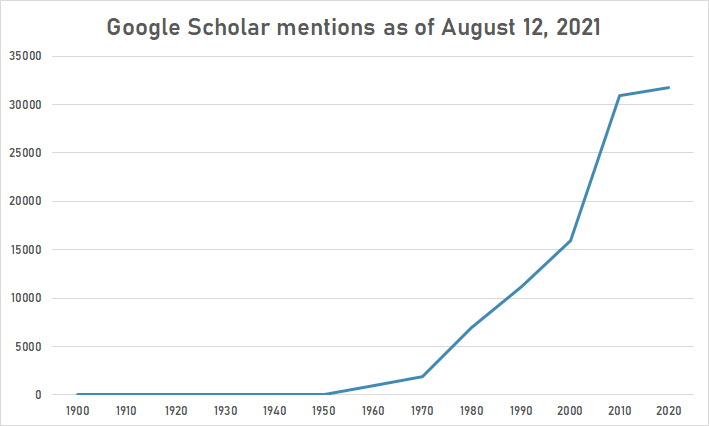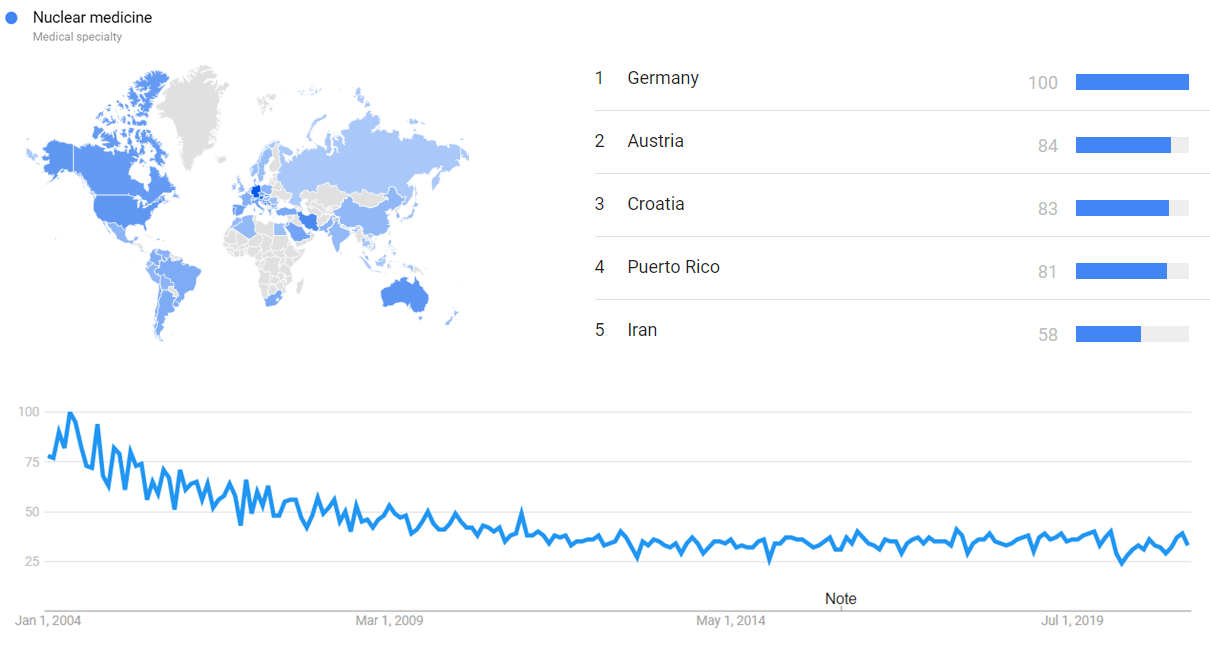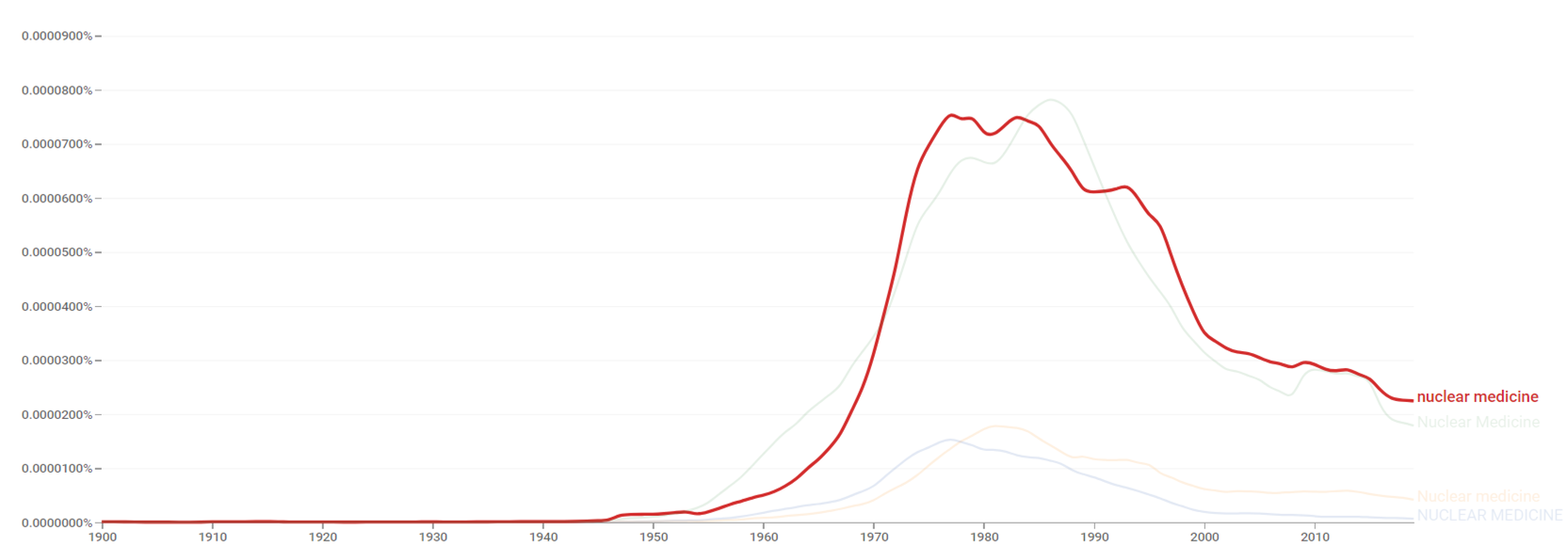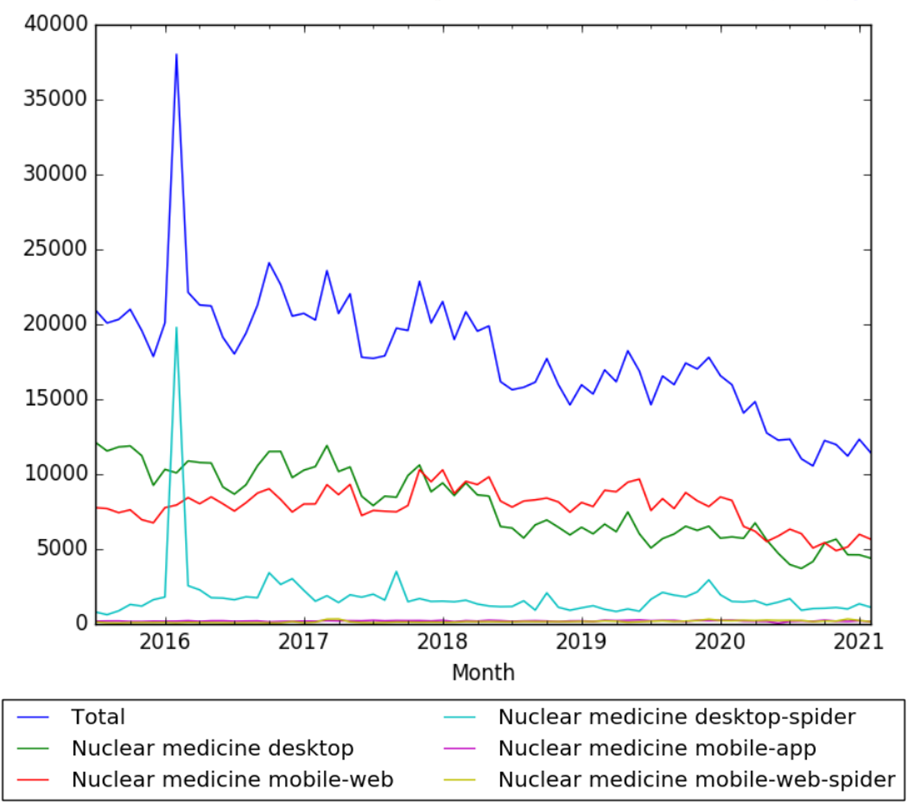Timeline of nuclear medicine
This is a timeline of nuclear medicine, describing significant events in the development of the field. Organizations, important conferences, journals and books are included.
Big picture
| Time period | Development summary |
|---|---|
| 1930s | The origin of nuclear medicine starts with the invention of the cyclotron by Ernest Lawrence.[1] The first uses of radioactive iodine and strontium for diagnostic purposes occur in the late decade.[2] |
| 1950s | By the 1950s, the clinical use of nuclear medicine becomes widespread as researchers increase their understanding of detecting radioactivity and using radionuclides to monitor biochemical processes.[3] The commercial use of radiopharmaceuticals begins in the decade.[2] |
| 1980s | The decade sees improvements in computer networking systems with enhanced image resolution. Rubidium is introduced for cardiac perfusion testing in the late 1980s.[2] |
| 1990s | The speed of the Internet improves through optical cabling satellite technology. New radiopharmaceuticals are introduced along with the use of FDG PET studies to assess patient response to chemotherapy treatments. The PET/CT scanner is first used on human patients.[2] |
Full timeline
| Year | Event type | Details | Location |
|---|---|---|---|
| 1896 | Scientific development | French physicist Henri Becquerel discovers that uranium emits penetrating rays similar to X-rays.[4] | France |
| 1911 | Scientific development | Hungarian chemist George de Hevesy, working under Ernest Rutherford at the Cavendish Laboratory, develops the idea that a radioactive substance, chemically unseparable from a stable substance, could be used as an indicator of the latter.[5] | United Kingdom |
| 1927 | Field development | Hermann Blumgart and Soma Weiss use Bi214 to measure circulation time from one arm to the other in both normal and abnormal patients. This is the first time a radionuclide is employed in diagnostic medicine.[5] | United States |
| 1928 | American scientist Ernest Lawrence starts working at University of California in Berkeley as a nuclear physicist.[1] | United States | |
| 1928 | Organization | The International Commission on Radiological Protection is formed.[6][7][8] | |
| 1929 | Organization | The U.S. National Council on Radiation Protection and Measurements is founded.[6] | United States |
| 1930 | Scientific development | American scientist Ernest Lawrence, at the University of California, Berkeley builds the first cyclotron which is only 4 inches in diameter. It involves 2 D-shaped magnets, which create a circular magnetic field, with a small gap between them. The alternating electric field accelerates the particles and causing the radius of the circular path to increase until it hits the target.[1][5] | United States |
| 1932 | Scientific development | British physicist James Chadwick discovers the neutron.[5] | United Kingdom |
| 1933 | Scientific development | Ernest Lawrence buid a machine capable of yielding a beam of 3 MeV deutrons and with an intensity equivalent to enormous quantities of radium in a Ra-Be source.[5] | United States |
| 1934 | Scientofoc development | Artificial radioactivity is first discovered,[3] when French physicists Frédéric Joliot-Curie and Irène Joliot-Curie are able to prove the production of an artificial radionuclide.[5] | France |
| 1935 | Scientific development | John H. Lawrence (Ernest Lawrence's brother), in his experiments on neutrons finds that they are far more dangerous than X-rays, resulting in the first safety measures being drawn up for the medical use of radioactive materials.[9] | |
| 1935 – 1939 | Field development | Use of radioactive iodine and strontium for diagnostic purposes begins.[2] | |
| 1936 | Field development | Hamilton and Stone in California, employ the first artificially produced radioisotope for therapeutic trials.[5] | United States |
| 1937 | Scientific development | Italian physicist Emilio Segrè discovers technetium from leftover molybdenum.[2] | Italy |
| 1942 | Scientofoc development | Italian physicist Enrico Fermi and co-workers achieve the first self-sustained nuclear chain reaction and the construction of the nuclear reactor begins.[5] | United States |
| 1946 | Field development | Radionuclides are first produced for medical use at the Oak Ridge National Laboratory.[3] | United States |
| 1946 | Field development | Nuclear medicine first becomes recognized as a potential medical speciality when it is described by Samuel M. Seidlin in the Journal of the American Medical Association. Seidlin reports on the success of radioactive iodine (I-131) in treating a patient with advanced thyroid cancer.[3] Radionuclides for medical and biological research are now available for general use and the first commercial announcement is published in an issue of the journal Science.[5] | United States |
| 1947 | Field development | The production of radionuclides at Harwell begins in the United Kingdom, prompting the start of nuclear medicine in the Nordic countries.[5] | United Kingdom |
| 1950 | Field development | Diagnostic nuclear medicine begins in Sweden with the thyroid in all the university hospitals with Bengt Skanse as the pioneer.[5] | Sweden |
| 1950 | Field development | Commercial use of radiopharmaceuticals begin.[2] | |
| 1950 – 1955 | Field development | Benedict Cassen and associates develop the rectilinear scanner, a machine that permits the user to scan the distribution of radioiodine in the thyroid gland.[2] | |
| 1951 | Organization | The Japan Radioisotope Association is formed.[10] | Japan |
| 1952 | Scientific development | American electrical engineer Hal Anger at Donner Laboratory in the USA constructs a pin-hole camera for gamma-rays. With this instrument, an image of the radionuclide distribution is obtained.[5] | United States |
| 1954 | Organization | The Society of Nuclear Medicine is formed in Spokane, Washington.[3] | United States |
| 1957 | Orgnization | The National Institute of Radiological Sciences is established in Japan.[11] | Japan |
| 1959 | Literature (book) | Specialized textbook Diagnostic radioisotopes is published. It contains 528 references concerning iodine metabolism, thyroid function and diagnostic tests.[5] | |
| 1961 | Field development | The first cyclotron is installed at Washington University Medical Center.[2] | United States |
| 1964 | Organization | The Swiss Society for Radiation Biology is founded in Geneva.[12] | Switzerland |
| 1964 | Literature | The Journal of Nuclear Medicine is first issued.[13] | |
| 1966 | Organization | The British Nuclear Medicine Society is founded.[14] | United Kingdom |
| 1967 | Organization | The Society of Nuclear Medicine, India (SNM-India) is founded with the aim to promote, encourage and help the development and advancement of Nuclear Medicine as a specialty in the country.[15] | India |
| 1968 | Literature (book) | Principles of Nuclear Medicine, by Henry N. Wagner, is published.[16] | |
| 1970 | The World Federation of Nuclear Medicine and Biology (WFNMB) is founded at the third ALASBIMN Congress in Mexico City.[17] | Mexico | |
| 1971 | Field development | The American Medical Association acknowledges nuclear medicine as an official medical specialty.[3] | United States |
| 1972 | Organization | The American College of Nuclear Medicine is founded to advance the science of nuclear medicine.[2] | United States |
| 1972 | Organization | The American Board of Nuclear Medicine is formed.[3] | United States |
| 1973 | Literature | The Journal of Nuclear Medicine Technology is established.[18] | |
| 1974 | Organization | The American College of Nuclear Physicians (ACNP) is established.[2] | United States |
| 1974 | Congress | The First World Congress of Nuclear Medicine is held in Tokyo and Kyoto, Japan.[17] | Japan |
| 1976 | Organization | The American Board of Science in Nuclear Medicine is founded.[19] | United States |
| 1976 | Literature (journal) | The European Journal of Nuclear Medicine and Molecular Imaging is first issued.[20] | |
| 1978 | Congress | The World Congress of Nuclear Medicine is held in Washington, D.C.. The congress is attended by approximately 1700 people.[17] | United States |
| 1979 | Literature (book) | Fundamentals of Nuclear Pharmacy, by Gopal B. Saha is published.[21] | |
| 1980 | Organization | The Chinese Nuclear Society is founded.[22] | China |
| 1980 | Literature (book) | James A. Sorenson publishes Physics in Nuclear Medicine.[23] | |
| 1982 | Congress | The World Congress of Nuclear Medicine is held in Paris.[17] | France |
| 1983 | Literature (book) | Fred A. Mettler, Milton J. Guiberteau publish Essentials of Nuclear Medicine Imaging.[24] | |
| 1984 | Literature (journal) | Peer-reviewed medical journal Magnetic Resonance in Medicine is first issued.[25] | |
| 1985 | Organization | The European Association of Nuclear Medicine is formed.[26] | |
| 1985 | Literature (book) | Pediatric Nuclear Medicine, by S.T. Treves is published.[27] | |
| 1986 | The World Congress of Nuclear Medicine is held in Buenos Aires.[17] | Argentina | |
| 1988 | Literature (book) | Ignac Fogelman publishes An Atlas of Clinical Nuclear Medicine.[28] | |
| 1989 | Literature (book) | Practical Nuclear Medicine, by Peter F. Sharp, is published.[29] | |
| 1990 | The World Congress of Nuclear Medicine is held in Montreal.[17] | Canada | |
| 1993 | Organization | The Society of Nuclear Medicine, Bangladesh is formed.[30] | Bangladesh |
| 1993 | Literature (book) | Physics and radiobiology of nuclear medicine, by Gopal B. Saha, is published.[31] | |
| 1993 | Organization | The American Society of Nuclear Cardiology is formed.[32] | United States |
| 1994 | Congress | The World Congress of Nuclear Medicine is held in Sydney.[17] | Australia |
| 1994 | Literature | The Journal of Nuclear Cardiology is first issued.[33] | |
| 1995 | Literature (book) | Harvey A. Ziessman, James H Thrall, and Janis P. O'Malley publish Nuclear Medicine: The Requisites.[34] | |
| 1996 | Organization | The Brazilian Society on Nuclear Biosciences is founded.[35] | Brazil |
| 1996 | Organization | The U.S. Certification Board of Nuclear Cardiology (CBNC) is founded by the American Society of Nuclear Cardiology to examine and certify as competent physicians working in nuclear cardiology.[2] | United States |
| 1998 | Literature (book) | Ramesh Chandra publishes Nuclear medicine physics.[36] | |
| 1998 | The World Congress of Nuclear Medicine is held in Berlin.[17] | Germany | |
| 2000 | Literature (book) | Nuclear Medicine Technology: Procedures and Quick Reference by Pete Shackett is published.[37] | |
| 2000 | Literature (book) | Diagnostic Nuclear Medicine, by Christiaan Schiepers, is published.[38] | |
| 2002 | Literature (book) | Nuclear Medicine Technology: Review Questions for the Board Examinations, by Abass Alavi and Karen Ramer, is published.[39] | |
| 2002 | The World Congress of Nuclear Medicine is held in Santiago.[17] | Chile | |
| 2002 | Literature (book) | Therapeutic Applications of Monte Carlo Calculations in Nuclear Medicine, by H. Zaidi and G Sgouros, is published.[40] | |
| 2002 | Statistics | 18.4 million nuclear medicine procedures were performed in 7,000 hospital and non-hospital provider sites in the United States.[2] | United States |
| 2004 | Literature (book) | Nuclear Medicine and PET/CT: Technology and Techniques by Kristen M. Waterstram-Rich and Paul Christian is published.[41] | |
| 2004 | Field development | Taylor et al report that indium is a very specific radionuclide that works well in detecting soft-tissue infection in the body.[2] | |
| 2006 | Congress | The World Congress of Nuclear Medicine is held in Seoul.[17] | South Korea |
| 2007 | Literature (book) | Clinical Nuclear Medicine, by Hans-Jürgen Biersack and Leonard M. Freeman, is published.[42] | |
| 2008 | Congress | The World Congress of Nuclear Medicine is held in Capetown.[17] | South Africa |
| 2010 | Literature (book) | Nuclear Medicine Instrumentation, by Jennifer Prekeges, is published.[43] | |
| 2012 | Literature (book) | Nuclear Medicine and Radiology, by Rahul Velez, is published.[44] | |
| 2014 | Congress | The World Congress of Nuclear Medicine is held in Cancun.[17] | Mexico |
| 2014 | Literature (book) | Therapeutic Nuclear Medicine is published.[45] | |
| 2015 | Literature (book) | Chirayu Shah and Marques Bradshaw publish Nuclear Medicine: A Core Review.[46] | |
| 2015 | Literature (book) | Diagnostic Imaging: Nuclear Medicine, by Paige Bennett and Umesh D. Oza, is published.[47] | |
| 2016 | Literature (book) | Quality in Nuclear Medicine, by Andor W.J.M. Glaudemans, Jitze Medema, Annie K. van Zanten, and Rudi A.J.O. Dierckx, is published.[48] | |
| 2018 | Congress | The World Congress of Nuclear Medicine is held in Melbourne.[17] | Australia |
Numerical and visual data
Google Scholar
The following table summarizes per-year mentions on Google Scholar as of August 12, 2021.
| Year | "nuclear medicine" |
|---|---|
| 1900 | 15 |
| 1910 | 74 |
| 1920 | 68 |
| 1930 | 40 |
| 1940 | 24 |
| 1950 | 32 |
| 1960 | 928 |
| 1970 | 1,880 |
| 1980 | 6,980 |
| 1990 | 11,200 |
| 2000 | 15,900 |
| 2010 | 30,900 |
| 2020 | 31,800 |

Google Trends
The chart below shows Google Trends data for Nuclear medicine, from January 2004 to April 2021, when the screenshot was taken. Interest is also ranked by country and displayed on world map.[49]

Google Ngram Viewer
The chart below shows Google Ngram Viewer data for Nuclear medicine, from 1900 to 2019.[50]

Wikipedia Views
The chart below shows pageviews of the English Wikipedia article Nuclear medicine, on desktop, mobile-web, desktop-spider, mobile-web-spider and mobile app, from July 2015 to February 2021.[51]

Meta information on the timeline
How the timeline was built
The initial version of the timeline was written by User:Sebastian.
Funding information for this timeline is available.
Feedback and comments
Feedback for the timeline can be provided at the following places:
- FIXME
What the timeline is still missing
Timeline update strategy
See also
External links
References
- ↑ 1.0 1.1 1.2 "The History of Nuclear Medicine". bris.ac.uk. Retrieved 15 November 2018.
- ↑ 2.00 2.01 2.02 2.03 2.04 2.05 2.06 2.07 2.08 2.09 2.10 2.11 2.12 2.13 "The Nuclear Medicine Workforce" (PDF). chwsny.org. Retrieved 3 January 2019.
- ↑ 3.0 3.1 3.2 3.3 3.4 3.5 3.6 "History of Nuclear Medicine". news-medical.net. Retrieved 15 November 2018.
- ↑ Rootwelt, K. "Henri Beckquerel's discovery of radioactivity, and history of nuclear medicine. 100 years in the shadow or on the shoulder of Röntgen". PMID 9019879.
{{cite journal}}: Cite journal requires|journal=(help) - ↑ 5.00 5.01 5.02 5.03 5.04 5.05 5.06 5.07 5.08 5.09 5.10 5.11 5.12 "A Glance At The History Of Nuclear Medicine". tandfonline.com. Retrieved 16 November 2018.
- ↑ 6.0 6.1 Eisenbud, Merrill; Gesell, Thomas F. Environmental Radioactivity from Natural, Industrial and Military Sources: From Natural, Industrial and Military Sources.
- ↑ Biddle, Wayne. A Field Guide to Radiation.
- ↑ Chicken, John C. Nuclear Power Hazard Control Policy.
- ↑ "History of Nuclear Medicine". study.com. Retrieved 16 November 2018.
- ↑ "Japan Radioisotope Association". jrias.or.jp. Retrieved 3 January 2019.
- ↑ "National Institute of Radiological Sciences". qst.go.jp. Retrieved 3 January 2019.
- ↑ "Swiss Society for Radiation Biology". ssrpm.ch. Retrieved 17 November 2018.
- ↑ "JNM". snmjournals.org. Retrieved 3 January 2019.
- ↑ "A History of Radionuclide Studies in the UK: 50th Anniversary of the British Nuclear Medicine Society". researchgate.net. Retrieved 17 November 2018.
- ↑ "Society of Nuclear Medicine, India". snmicon2018.com. Retrieved 17 November 2018.
- ↑ "Principles of Nuclear Medicine". Retrieved 17 November 2018.
- ↑ 17.00 17.01 17.02 17.03 17.04 17.05 17.06 17.07 17.08 17.09 17.10 17.11 17.12 "World Federation of Nuclear Medicine and Biology World Federation of Nuclear Medicine and Biology". wfnmb.org. Retrieved 17 November 2018.
- ↑ "JNMT". snmjournals.org. Retrieved 3 January 2019.
- ↑ "The American Board of Science in Nuclear Medicine". absnm.org. Retrieved 3 January 2019.
- ↑ "EJNMMI – European Journal of Nuclear Medicine and Molecular Imaging". eanm.org. Retrieved 3 January 2019.
- ↑ "Fundamentals of nuclear pharmacy". Retrieved 17 November 2018.
- ↑ Wang, Shih-Chen; Chou, Chien. "A brief overview of nuclear medicine in China". doi:10.1016/S0001-2998(89)80008-X.
{{cite journal}}: Cite journal requires|journal=(help) - ↑ "Physics in Nuclear Medicine". Retrieved 17 November 2018.
- ↑ Mettler, Fred A.; Guiberteau, Milton J. Essentials of Nuclear Medicine and Molecular Imaging.
- ↑ "Magnetic Resonance in Medicine". wiley.com. Retrieved 3 January 2019.
- ↑ "General Information". eanm.org. Retrieved 3 January 2019.
- ↑ "Pediatric Nuclear Medicine". Retrieved 17 November 2018.
- ↑ "An Atlas of Clinical Nuclear Medicine". Retrieved 17 November 2018.
- ↑ "Practical Nuclear Medicine". Retrieved 17 November 2018.
- ↑ "Society of Nuclear Medicine, Bangladesh". snm-bd.org/. Retrieved 17 November 2018.
- ↑ "Physics and radiobiology of nuclear medicine". Retrieved 17 November 2018.
- ↑ "Nuclear Medicine: The Requisites". Retrieved 17 November 2018.
- ↑ "Journal of Nuclear Cardiology". springer.com. Retrieved 3 January 2019.
- ↑ "Nuclear Medicine: The Requisites". abebooks.com. Retrieved 3 January 2019.
- ↑ "Brazilian Society on Nuclear Biosciences". sbbn.org.br. Retrieved 17 November 2018.
- ↑ "Nuclear medicine physics". Retrieved 17 November 2018.
- ↑ "Nuclear Medicine Technology: Procedures and Quick Reference". Retrieved 17 November 2018.
- ↑ "Diagnostic Nuclear Medicine". Retrieved 17 November 2018.
- ↑ "Nuclear Medicine Technology: Review Questions for the Board Examinations". Retrieved 17 November 2018.
- ↑ "Therapeutic Applications of Monte Carlo Calculations in Nuclear Medicine". Retrieved 17 November 2018.
- ↑ "Nuclear Medicine and PET/CT: Technology and Techniques". Retrieved 17 November 2018.
- ↑ "Clinical Nuclear Medicine". Retrieved 17 November 2018.
- ↑ "Nuclear Medicine Instrumentation". Retrieved 17 November 2018.
- ↑ "Nuclear Medicine and Radiology". Retrieved 17 November 2018.
- ↑ "Therapeutic Nuclear Medicine". Retrieved 17 November 2018.
- ↑ "Nuclear Medicine: A Core Review". Retrieved 17 November 2018.
- ↑ "Diagnostic Imaging: Nuclear Medicine". Retrieved 17 November 2018.
- ↑ "Quality in Nuclear Medicine". Retrieved 17 November 2018.
- ↑ "Nuclear medicine". Google Trends. Retrieved 12 April 2021.
- ↑ "Nuclear medicine". books.google.com. Retrieved 25 March 2021.
- ↑ "Nuclear medicine". wikipediaviews.org. Retrieved 25 March 2021.